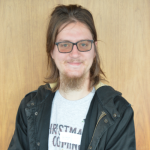This year, we have a joint win for our Month 6 Presentation Prize: congratulations to first year PGRs Joe Pitfield (also the winner of the Month 13 Presentation Prize)and Leanne Stanfield. They will be collecting their mystery prize soon…
The Month 6 presentations are given each May by first year PGRs, at the end of the six month mini project the students undertake before beginning their PhD project work. Feedback scores are given by their peers and by academic chairs (this year Dr Anna Katharina Ott and Dr Eric Hébrard took on these roles). Leanne’s presentation was titled ‘Graded negative index surface wave lens’ and Joe’s was titled ‘Structural stability of TMDC Heterostructures in the Presence of Water ’. Please find their projects aims and methodology below.
Graded negative index surface wave lens
Leanne Stanfield
Aim:
Model, fabricate and characterise a graded negative index surface wave lens. One study has
already produced a free-space negative index gradient lens [1]. The aim here is to do this with surface
waves.
Methodology:
1. Develop Comsol modelling of microwave metasurfaces made of simple meta-atoms to give easy control of the surface wave index. Then vary the size of the individual elements to design a simple surface wave GRIN lens. This is a very demanding task using Comsol as the GRIN lens will need
modelling in its entirety. Once this task is complete the lens will be fabricated using wax-ink printing
and etching before being fully characterised using the XY microwave scanner.
2. Repeat the above with a more elaborate meta-atom, following on from the work of Tremain
et al [2], to give almost almost isotropic negative dispersion. Once again then vary the size of the
individual elements so that they allow for spatial control of the effective surface mode index. Then
combine such elements in a 2D metasurface structure to form a negative index GRIN lens. As for the
conventional lens this is a very demanding task using Comsol as again the GRIN lens will need
modelling in its entirety. The complete lens will then be fabricated using wax-ink printing and etching
before being fully characterised using the XY microwave scanner.
References
[1] Driscoll T, Basov DN, Starr AF, Rye PM, Nemat-Nasser S, Schurig D and Smith DR (2006) Applied
Physics Letters 88, 081101 ‘Free-space microwave focusing by negative-index gradient lens.’
[2] Tremain B’ Hooper I R, Sambles JR and Hibbins AP (2018) Scientific Reports 8, 7098 ‘Isotropic
Backward Waves Supported by a Spiral Array Metasurface.’
Structural stability of TMDC Heterostructures in the Presence of
Water
Joe Pitfield
Aim:
To explore the random structures and reorganisation of TMDC metamaterials in the presence of
water, with addition consideration of substrate effects.
Methodology:
First principles calculations combined with analytic Gibb’s Free energy arguments. In
addition, random structure prediction will be developed as a tool. This tool will require a sound
understanding of both physical and chemical environments and allow the prediction of new phases of
structures. It will need to be benchmarked against known phases.
References:
[1] F. Davies et al. TMDC Heterostructure band structure theory (submitted – preprint available)
[2] G. Schusteritsch et al. First-principles structure determination of interface materials: The NixInAs
nickelides, Phys. Rev. B, 2015.
[3] Heifets et al, BaZrO3, Phys. Rev. B, 75, 155431 (2007)

